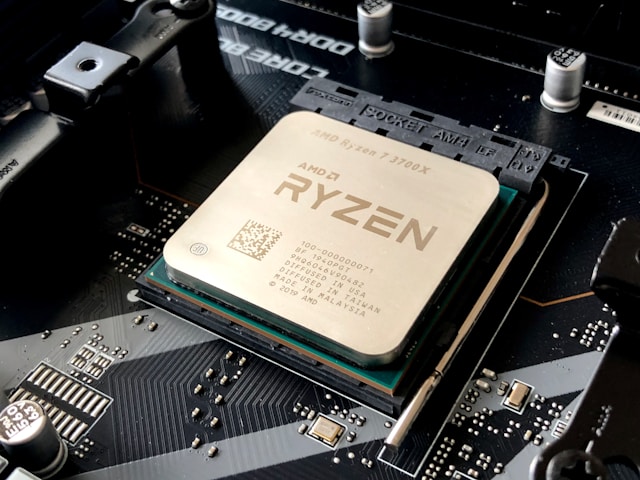
Financial Highlights
Advanced Micro Devices (AMD) reported quarterly revenue of $6.8 billion for the period ending September 28, 2024, marking an 18% year-over-year increase. This growth was primarily driven by strong performances in the Data Center and Client segments. Revenue in the Data Center segment surged to $3.5 billion, up 122% from $1.6 billion in the same period last year, largely due to increased shipments of AMD Instinct™ GPUs and expanded sales of EPYC™ CPUs. Similarly, the Client segment saw revenues rise by 29% to $1.9 billion, supported by robust demand for the “Zen 5” Ryzen™ processors.
However, the Gaming and Embedded segments experienced declines, with revenues decreasing by 69% and 25%, respectively. The decline in the Gaming segment was mainly due to a reduction in semi-custom revenues, while the Embedded segment was impacted by customers normalizing their inventory levels. Despite these negative factors, the growth in key segments outweighed the overall sales increase.
Gross profit margins improved to 50%, up from 47% in the same quarter last year, driven by the rise in Data Center revenues. Operating income increased significantly to $724 million from $224 million year-over-year. Net income also rose to $771 million from $299 million, supported by high revenues, improved gross margins, and reduced amortization expenses related to acquisitions, although increased operating expenses partially offset these gains.
In terms of financial position, cash and cash equivalents combined with short-term investments decreased to $3.9 billion, while cash flow from operating activities remained strong at $1.7 billion. Investment activities provided $113 million in cash, an improvement from the $157.3 million used in the same period last year. Financing activities utilized $1.891 billion in cash, primarily due to debt repayments and stock buybacks. Notably, the repayment of $750 million in 2.95% senior notes in June 2024 had a significant impact.
Acquisition Activity
On August 9, 2024, AMD acquired Finnish AI research firm Silo AI for $665 million, enhancing its capabilities in AI model development and deployment. Additionally, on August 17, 2024, AMD entered into an acquisition agreement with ZT Systems, planning a total transaction of $4.9 billion in cash and stock, expected to be completed in the first half of 2025. The manufacturing business of ZT Systems is slated to be sold to a strategic partner.
Segment Performance
The Data Center and Client segments exhibited strong growth, while the Gaming and Embedded segments showed no signs of recovery. Specifically, the Data Center segment benefited from strong demand for AMD Instinct™ GPUs and EPYC™ CPUs, leading to a substantial increase in operating income. The Client segment also saw improved revenues and operating income due to increased demand for the “Zen 5” Ryzen™ processors.
Conversely, the Gaming segment’s revenues plummeted due to decreased demand for semi-custom products, and the Embedded segment saw reduced revenues from inventory normalization by customers. Addressing the recovery of these segments remains a future challenge, but overall performance remains robust thanks to growth in the primary segments.
Future Outlook
Looking ahead, AMD plans to continue pursuing acquisitions as part of its AI strategy while sustaining growth in the Data Center and Client segments. The company is also actively engaged in shareholder returns through its stock buyback program, aiming to maintain a stable financial foundation while advancing its growth strategy.
Risk Warnings
Economic and Strategic Risks: AMD faces challenges competing on a level playing field against major rivals like Intel and Nvidia, whose market dominance and aggressive business strategies could adversely affect AMD’s market share and profit margins. The semiconductor industry’s cyclical nature, demand fluctuations, and rapid technological advancements can significantly impact performance. Additionally, the growing AI market intensifies competition, and any lag in technological innovation could erode AMD’s competitive edge.
Operational and Technical Risks: Dependence on third-party manufacturers poses risks related to production capacity and potential supply shortages or cost increases. Delays in new product design or launches could result in lost market share. Cybersecurity vulnerabilities or data breaches could severely impact the company’s reputation and financial health.
Legal and Regulatory Risks: Export restrictions and trade protection measures, especially concerning China and Russia, could limit AMD’s ability to sell products to certain customers, directly affecting revenue and manufacturing processes. Intellectual property lawsuits and compliance with environmental regulations also present legal risks. New regulations and ethical concerns related to AI technology use add further uncertainty to business operations.
Merger, Acquisition, and Integration Risks: The acquisitions of ZT Systems and the integration of Silo AI may not achieve the expected synergies or could face delays and failures, negatively impacting AMD’s performance and financial status. Integrating new businesses requires substantial resources and time, potentially disrupting existing operations.
General Risks: Global political and economic instability, as well as natural disasters, could directly affect AMD’s operations and supply chain. Geopolitical tensions and natural disasters in regions like Taiwan and China pose significant risks to manufacturing facilities. Climate change-related regulations and increased costs for environmental measures also present long-term operational risks.
Growth Opportunities
In the embedded computing market, AMD continues to maintain leadership by focusing on product development tailored to various markets and devices. The adoption of AMD Versal is expanding in the aerospace and emulation markets.
In the Client market, AMD is enhancing performance and energy efficiency for productivity, AI, gaming, and content creation. The newly introduced Ryzen AI PRO 300 series processors are driving the promotion of next-generation AI PCs for enterprises with low power consumption.
For the Data Center segment, AMD aims to optimize cost performance for cloud, enterprise, and AI workloads, maintaining its industry leadership and market dominance. In the gaming market, AMD plans to deliver immersive experiences for PC and console users, with an expected increase in the use of AMD semi-custom SoCs in the PS5 Pro.
These risk factors highlight vulnerabilities in AMD’s business model and market environment, serving as significant concerns for investors and stakeholders. As competition with NVIDIA intensifies and the emergence of new major players looms, AMD’s future growth and market position will depend on its ability to navigate and overcome these competitive challenges.
Source:finviz




